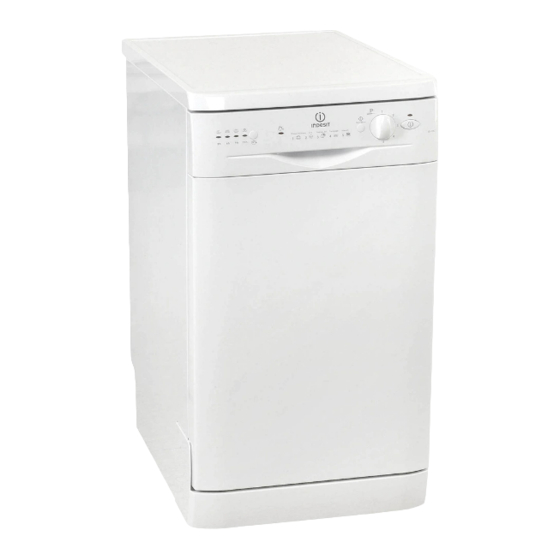- ページ 22
食器洗い機 Indesit IDL 420のPDF 設置および使用マニュアルをオンラインで閲覧またはダウンロードできます。Indesit IDL 420 25 ページ。

- 1. Mise en Service
- 2. Installation
- 3. Safety Is a Good Habit to Get into
- 4. Close-Up View (Control Panel)
- 5. Close-Up View (Interior)
- 6. Detergent and Rinse Aid
- 7. Loading the Dishwasher
- 8. Turning on the Appliance
- 9. Wash Cycle Table
- 10. Energy Saving Tips
- 11. How to Keep Your Dishwasher in Shape
- 12. Disposal of Old Electrical Appliances
- 13. Cleaning and Special Maintenance
- 14. Troubleshooting
Installation
Positioning the Appliance
Position the appliance in the desired location. The back
should rest against the wall behind it, and the sides, along
the adjacent cabinets or wall. The dishwasher is equipped
with water supply and drain hoses that can be positioned
to the right or the left to facilitate proper installation.
Levelling the Appliance
Once the appliance is positioned, adjust the feet (screwing
them in or out) to adjust the height of the dishwasher,
making it level. In any case, the appliance should not be
inclined more than 2°.
If the appliance is level, it will help ensure proper perfor-
mance.
This dishwasher model can be built under a single worktop
(please read the relevant instruction sheet).
Anti-flooding protection
Your dishwasher is provided with a special system which
blocks the water supply in the event of leaks inside the
appliance.
Cold Water Connection
This electric household appliance should be connected
to the water mains using the cold water supply hose
provided with the appliance only. Do not use a different
hose. In the event of replacements, use original spare
parts only.
Connect the cold water supply hose to a threaded 3/4
(gas) connector, and making sure that it is fastened tightly
in place. If the water pipes are new or have not been used
for an extended period of time, let the water run to make
sure that the water is clear and free of impurities. If this
precaution is not taken, there is a risk that the water inlet
can get blocked and damage the appliance.
- It is strongly recommended to use a new hose to connect
the dishwasher to the water supply line, and the old hose-
set should not be reused. Asking to specilized shop or
an authorized service technician (see Service).
Hot Water Connection
The water supply to the appliance can also be connected
to the house's hot water line (centralised system, heating
system), as long as it does not exceed a temperature of
60° C.
In this case, the wash cycle time will be shortened by
about 15 minutes and the wash efficiency slightly reduced.
The connection must be made to the hot water line following
the same procedures as those for the connection to the
cold water line.
EN
Drain Hose Connection
Fit the drain pipe into a drain
line with a minimum diameter
of 4 cm or place it over the
sink. Avoid restricting or
bending it. Use the special
plastic elbow provided (see
figure) to position it in the
best possible way. The part
of the pipe marked with the
letter A should be between 40 and 100 cm above the
ground.
The pipe should not be immersed in water.
Attention: The special plastic hose support must be
solidly fastened to the wall to prevent the drain hose
from moving and allowing water to spill outside the drain.
Electrical Connection
After making sure that the voltage and frequency values
for the current in the home correspond to those on the
rating plate (located on the stainless steel inner door of
the appliance) and that the electrical system is sized for
the maximum voltage on the rating plate, insert the plug
into an electrical socket which is earthed properly (the
earthing of the appliance is a safety requirement mandated
by law). If the electrical socket to which the appliance
must be connected is not appropriate for the plug, replace
the plug, rather than using adpators or the like as they
could cause overheating and burns.
Caution:
- Once the appliance has been installed, the electrical
plug and socket should remain accessible.
- If the power supply cable is damaged, it must be
replaced by the manufacturer or its Technical Assistance
Service in order to prevent all potential hazards. (See
Assistance)
- The cable should not be bent or compressed.
- The Company shall not be held responsible for any
incidents that occur if these regulations are not observed.
20
A
